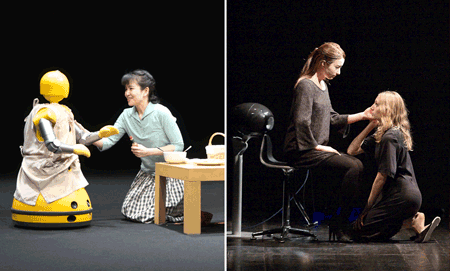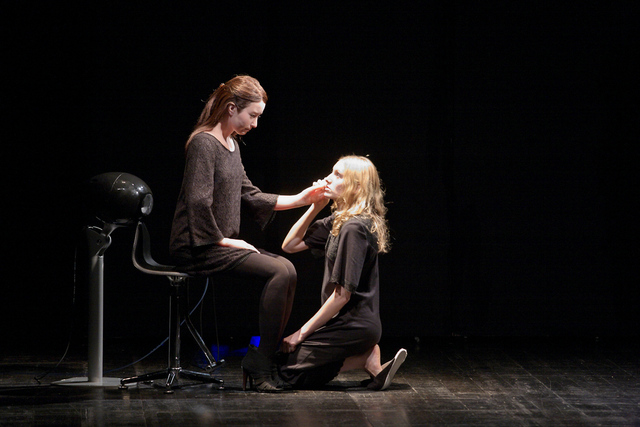
Robot Theater Project includes a pair of one-act plays starring real robots at Japan Society (photos by Tsukasa Aoki and Tatsuo Nambu)
Japan Society
333 East 47th St. at First Ave.
February 7-9, $28, 7:30
212-715-1258
www.japansociety.org
Last month the Resonance Ensemble revived Karel Čapek’s 1920 play, R.U.R., the work that introduced the word “robot” to the world — and a highly influential story that involved machines gaining sentience and threatening humankind. Seinendan Theater Company takes that to the next level this week at Japan Society with Robot Theater Project, a pair of one-act plays written and directed by company founder Oriza Hirata in which real robots play characters onstage. In Sayonara, a woman with a terminal illness is cared for by Geminoid F, described in the cast biographies as “a female type tele-operated android [with the] potential to go beyond an experimental platform and become a commonly used robot in human society.” In I, Worker, a man struggles to deal with the loss of his child while his robot questions the meaning of life; the mechanical being is played by Robovie R3, “a life-sized robot invented to research communications between humans and robots.” While Geminoid F is making its theatrical debut, Robovie R3 previously appeared in Hirata’s Three Sisters, Android Version. The human actors include Bryerly Long, Hiroshi Ota, and Minako Inoue. The two plays, developed in collaboration with Dr. Hiroshi Ishiguro of the Intelligent Robotics Laboratory at Osaka University, will be performed February 7-9 at Japan Society, Sayonara in English and Japanese with subtitles and I, Worker in Japanese with subtitles. Hirata and Dr. Ishiguro will participate in Q&As following the February 8-9 shows. In addition, Hirata will lead an acting workshop, “Exploring Naturalism,” on February 9 at 1:00, delving into his unique “contemporary colloquial theater.”

Robots and humans interact in moving ways at Japan Society
Update: As the audience enters the Japan Society theater for Sayonara, the first of a pair of one-act plays, two characters are already onstage, sitting in chairs. Although it appears to be two women, one brunette and Asian, the other blonde and Caucasian, it turns out that while the latter is a living, breathing female, Bryerly Long as a young woman dying of a terminal disease, the former is Geminoid F, a remarkably realistic android playing a robot who has been hired by the woman’s father to recite beautiful poetry to make his daughter’s final days peaceful. Geminoid F, who is powered through air pressure via twelve motorized actuators, doesn’t mouth the words exactly, which, along with her vacant eyes, are the only things that give her away as a mechanical being until she is carried off at the end, a long tube connecting her to electronic controls. The interplay between the android and the human is quite moving and believable, with a new scene added involving the nuclear disaster at Fukushima and how robots can help in the aftermath. In I, Worker, Hiroshi Ota (who also plays a small part in Sayonara) and Minako Inoue (who voices Geminoid F) are parents trying to cope with the death of their child. The husband is having more difficulties getting back to a relatively normal existence, which is also the case with the family’s two robots, played by Robovie R3s. While Geminoid F was created to look like a human, Robovie R3 is more in the mode of a futuristic R2D2/Dr. Who type, with fanciful colors and round, wide eyes. Just like the parents, the male robot has lost purpose in his life and is trying to find the will to go on, but I, Worker contains much more humor, supplied by the robots themselves, including how they exit the stage at the end. The two plays work because writer-director Oriza Hirata has created two pieces in which the stories themselves deal with the interchange between humans and robots; he has not cast the androids as real people going through completely real situations, and human actors are not playing robots. The plays would not be successful if they were performed only by robots or only by humans; instead, by bringing the two together, Hirata and robotic scientist Dr. Hiroshi Ishiguro have built a fascinating meta that surrounds the tales, a harbinger of things to come both on- and offstage in our ever-evolving world.